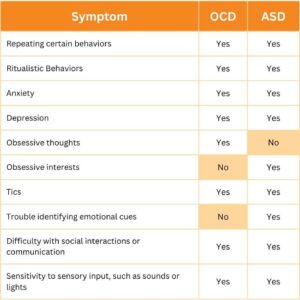February 23, 2024
Obsessive Compulsive Disorder & Autism Spectrum Disorder
By: Christine Charpie, MSW Practicum Student, & Janelle Schenk, MSW
Introduction
Obsessive Compulsive Disorder (OCD) is often misdiagnosed (Glazier et al., 2015). Furthermore, distinguishing OCD from Autism Spectrum Disorder (ASD) can be challenging, as there is considerable overlap in their symptoms (Haghighi et al., 2022). This blog serves to help us better understand the gray area between OCD and ASD, as well as possible intervention strategies for autistic individuals also struggling with OCD.
What is Obsessive Compulsive Disorder?
According to the DSM-5, OCD is defined as the presence of obsessions (typically thoughts), compulsions (typically behaviors), or both.
Obsessions may be difficult to label due to the mental nature of most obsessions. Some examples of obsessions may be: contamination, perfectionism, religious/moral, hoarding, intrusive, and somatic or preoccupations with the body obsessions. These are only but a few examples of obsessions. At times, obsessions may be followed by compulsions. Some examples of compulsions include: ordering and arranging objects, excessive cleaning or hand washing, checking (such as locks, candles, hair straighteners, etc.), and reassurance seeking repeatedly.
Misdiagnosis & Comorbidity of OCD
Misdiagnosis and comorbid disorders are fairly common with OCD. OCD presents in a variety of ways, giving way to a higher risk of misunderstanding the disorder or misdiagnosing entirely.
- After surveying 228 physicians, the overall misidentification rate of OCD was slightly over half (Glazier et al., 2015).
Comorbidity refers to the presence of two or more disorders or illnesses occurring in the same person at the same time. Diagnosing OCD can be challenging when a person has other co-occurring disorders at the same time. OCD is often accompanied by other related conditions like mood disorders, anxiety disorders, neurodevelopmental disorders, and other obsessive-compulsive related disorders.
- Around 6% of children with OCD may have comorbid ASD, and conversely, OCD in children with ASD is almost double (Sharma et al., 2021)
OCD and ASD Fast Facts
- OCD had a 13 times higher risk of having a comorbid ASD diagnosis compared to individuals without OCD (Meier et al., 2015)
- Individuals first diagnosed with ASD had a 2 fold higher risk of receiving a later diagnosis of OCD compared with individuals without ASD (Meier et al., 2015)
- OCD is considered to be ego-dystonic in nature, meaning thoughts and compulsions experienced or expressed are not consistent with the individual’s self perception and they intend to resist them.

Table showing the similar symptoms between OCD and ASD. This exemplifies how difficult it may be to differentiate between the two diagnoses.
Interventions for OCD and ASD
For treating both OCD and ASD simultaneously it is important to take into account the strengths of both, and where we could see improvements. Identifying the difference between what is considered ‘distressing’ is a good starting point.
- Common OCD treatments such as Cognitive Behavioral Therapy (CBT) can be modified and adapted for autistic adults and children who also have OCD (Gorbis & Dooley, 2011).
- Exposure therapy must be gradual and specific (Gorbis & Dooley, 2011).
- Not taking away repetitive behaviors or compulsions that are seemingly soothing, or are not connected to an intrusive thought (Gorbis & Dooley, 2011).
- ASD should continue to include emotional regulation and skill-building interventions.
Summary/Conclusion
Many behaviors associated with OCD such as anxiety, repetitive behaviors, and social challenges are very typical of those with ASD. However, it is important to note that interventions and treatments for those presenting with both OCD and ASD differ between diagnoses.
References
- American Psychiatric Association. (2013). Diagnostic and statistical manual of mental disorders (5th ed.). https://doi.org/10.1176/appi.books.9780890425596
- Glazier K, Swing M, McGinn LK. (2015).Half of obsessive-compulsive disorder cases misdiagnosed: vignette-based survey of primary care physicians. J Clin Psychiatry, 76(6), e761-7. doi: 10.4088/JCP.14m09110.
- Gorbis, E., &, Dooley, L. (2011). Treatments for obsessive-compulsive disorder comorbid with autism spectrum disorder. IOCDF. https://iocdf.org/expert-opinions/treatments-for-obsessive-compulsive-disorder-comorbid-with-autism-spectrum-disorder/
- Haghighi, A.S. (2022, December 16). What to know about OCD vs. autism. Medical News Today. https://www.medicalnewstoday.com/articles/ocd-vs-autism
- Meier, S. M., Petersen, L., Schendel, D. E., Mattheisen, M., Mortensen, P. B., & Mors, O. (2015). Obsessive-Compulsive Disorder and Autism Spectrum Disorders: Longitudinal and Offspring Risk. PloS one, 10(11), e0141703. https://doi.org/10.1371/journal.pone.0141703
- Sharma, E., Sharma, L.P., Balachander, S., Lin, B., Manohar, H., Khanna, P., Lu, C., Garg, K., Thomas, T.L., Au, A.C.L., Selles, R.R., Højgaard, D.R.M.A., Skarphedinsson, G., & Stewart, S.E. (2021). Comorbidities in obsessive-compulsive disorder across the lifespan: A systematic review and meta-analysis. Front Psychiatry, 12, 703701. doi: 10.3389/fpsyt.2021.703701.
Stahnke, B. (2021). A systematic review of misdiagnosis in those with obsessive-compulsive disorder. Journal of Affective Disorders Reports, 6, 100231.
